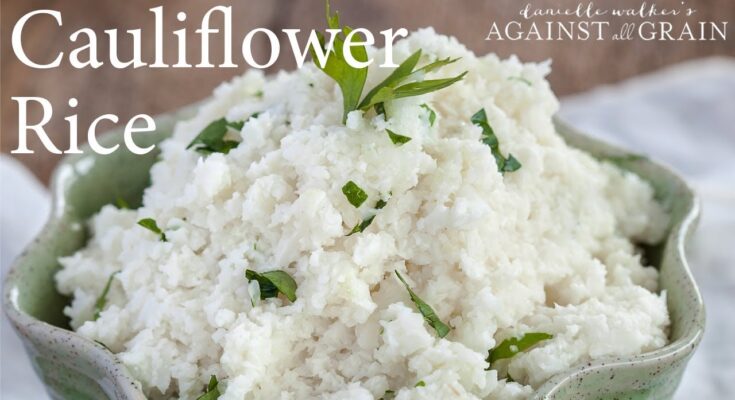Cauliflower Rice Recipe: Cauliflower rice is essentially cauliflower that has been chopped or grated into small, rice-sized pieces. Think of it as a fluffy, light, grain-free version of traditional rice that you can use in virtually any dish where you’d normally reach for rice. Whether you’re cutting carbs, following a gluten-free diet, or just trying to get more veggies on your plate, cauliflower rice is your go-to alternative.
What’s neat about it? It’s super versatile. It can be stir-fried, steamed, baked, or even served raw in a salad. The texture is surprisingly similar to cooked white rice, and it takes on the flavor of whatever you’re cooking it with. It’s like the chameleon of vegetables.
Why Choose Cauliflower Rice?
First off, cauliflower rice is an absolute winner in the nutrition department. Compared to regular rice, it’s significantly lower in calories and carbs. A cup of white rice clocks in at around 200 calories and 45 grams of carbs, while cauliflower rice? You’re looking at just 25 calories and about 5 grams of carbs. That’s a huge difference, especially if you’re watching your waistline.
Cauliflower is rich in fiber, vitamin C, vitamin K, and antioxidants. This makes it not just a filler or substitute, but an actual nutritional upgrade. It supports digestion, boosts immunity, and helps in reducing inflammation.
Also, making your own cauliflower rice is a great way to avoid processed or packaged foods. You’re in control of the ingredients, and you can keep it clean, fresh, and healthy.
Ingredients Needed
Fresh Ingredients
To make the most basic and delicious cauliflower rice, here’s what you’ll need:
- 1 large head of cauliflower (or two small ones)
- 1 tablespoon olive oil or butter
- Salt (to taste)
- Pepper (to taste)
That’s it! With just these basic ingredients, you’re already well on your way to creating a flavorful and nutritious base.
Optional Add-Ons and Variations
Want to jazz things up a bit? Here are some great additions:
- Garlic or onion powder – For that aromatic kick
- Lime juice and cilantro – For a Mexican-inspired dish
- Soy sauce and sesame oil – For an Asian twist
- Chopped herbs like parsley or basil – Fresh and vibrant
- Grated parmesan cheese – If you’re going for something savory and indulgent
You can even throw in some chopped veggies like peas, carrots, or bell peppers to make it more of a complete meal.
Tools and Kitchen Equipment
Essentials for Making Cauliflower Rice
You don’t need fancy equipment to make cauliflower rice. Here’s a basic list of what you’ll use:
- Sharp knife – To cut the cauliflower into manageable pieces
- Cutting board – To safely chop your veggie
- Box grater or food processor – To “rice” the cauliflower
- Large skillet or pan – For cooking
- Spatula or wooden spoon – To stir while cooking
Alternatives and Hacks
If you don’t have a food processor or grater, no worries. You can finely chop the cauliflower with a knife. It takes a bit more time and effort, but it gets the job done. Some people even pulse the cauliflower in a blender with short bursts, just be careful not to puree it.
Step-by-Step Instructions to Make Cauliflower Rice
Step 1 – Prepping the Cauliflower
Start by removing the green leaves and the stem from the cauliflower. Rinse it under cold water and pat it dry with a clean towel. It’s important to dry it well so your rice doesn’t turn out soggy.
Then, chop the cauliflower into medium-sized florets. Make sure they’re small enough to fit in your food processor if you’re using one.
Step 2 – Grating or Processing the Cauliflower
Now comes the fun part. If you’re using a food processor, attach the grating blade or use the regular blade and pulse the florets in small batches. Don’t overload it or you’ll end up with uneven pieces.
If you’re going old school, take out your box grater and grate each floret against the medium-sized holes. Be careful with your fingers—it can get a little slippery.
Your end product should look like grains of rice or couscous. Try to keep the texture consistent so it cooks evenly.
Step 3 – Cooking the Cauliflower Rice
Heat a tablespoon of olive oil or butter in a large skillet over medium heat. Once hot, toss in the cauliflower rice. Spread it out evenly and let it cook for about 5-8 minutes, stirring occasionally.
You want to cook it until it’s tender but not mushy. A little bit of browning is okay—it adds flavor. Don’t add water unless it’s sticking to the pan, because cauliflower already has a high moisture content.
Step 4 – Seasoning and Enhancing Flavor
Once the rice is cooked through, it’s time to season. A basic sprinkle of salt and pepper does wonders, but feel free to go wild. Add garlic powder, paprika, lemon zest, or even a splash of hot sauce. This is your moment to make it your own.
Serving Suggestions and Meal Ideas
Best Pairings with Cauliflower Rice
Cauliflower rice is like the blank canvas of the culinary world—it pairs beautifully with just about anything. One of its biggest strengths is its adaptability. Whether you’re in the mood for something spicy, savory, or sweet and tangy, cauliflower rice can rise to the occasion.
Here are some of the most delicious ways to serve it:
- Stir-fries: Replace regular rice with cauliflower rice in your favorite stir-fry. It absorbs the sauces and flavors while keeping things light.
- Curry dishes: Serve it under a rich Indian or Thai curry. It does a great job soaking up creamy sauces.
- Buddha bowls: Layer it in a bowl with grilled veggies, beans, avocado, and your favorite dressing.
- Stuffed peppers: Use it as a low-carb stuffing for bell peppers or tomatoes.
- Breakfast bowls: Try it with scrambled eggs, avocado, and a sprinkle of cheese for a hearty morning meal.
It’s also perfect as a base for burrito bowls, Mediterranean dishes with hummus and falafel, or even under a simple grilled chicken breast with a drizzle of lemon.
Low-Carb Meal Inspiration
If you’re eating low-carb, cauliflower rice can totally revolutionize your meal planning. Instead of relying on grains or starches, you can use cauliflower rice to fill out your plate with texture, bulk, and nutrients.
Some low-carb combos include:
- Cauliflower rice and grilled salmon with asparagus and lemon-butter sauce
- Cauliflower fried rice with eggs, peas, carrots, and a splash of soy sauce
- Taco bowls with seasoned ground beef, cauliflower rice, salsa, cheese, and lettuce
- Cauliflower rice sushi – yes, it’s a thing! Mix with cream cheese or avocado to help bind it and roll it up with seaweed and fish.
No matter your dietary style—keto, paleo, Whole30, or just eating clean—cauliflower rice fits right in.
Storage Tips and Reheating
How to Store Leftovers
Cauliflower rice is incredibly meal-prep-friendly. If you’ve made a big batch, storing it properly ensures you can enjoy it throughout the week.
Here’s how to store it:
- Refrigerator: Store cooked cauliflower rice in an airtight container for up to 4 days. If it’s raw, it can stay fresh for about 2-3 days before it starts to smell or soften too much.
- Freezer: You can also freeze it—raw or cooked! For best results, spread the rice out on a baking sheet and freeze for about 30 minutes before transferring it to a sealed freezer bag. This prevents clumping and keeps it fluffy when you defrost it.
Label your containers with the date so you don’t forget when you made it.
Best Ways to Reheat
To reheat, simply toss it back into a skillet over medium heat. A splash of olive oil or a pat of butter helps revive the flavor and texture. You can also microwave it, but be sure to cover it and stir halfway through to avoid cold spots.
Avoid overcooking it during reheating—it can turn mushy quickly. Just heat until warmed through and you’re good to go.
Nutritional Benefits of Cauliflower Rice
Health Advantages
Let’s talk about why cauliflower rice isn’t just a trend—it’s a powerhouse.
This veggie is low in calories but high in vitamins and antioxidants. A one-cup serving of cauliflower rice offers:
- Vitamin C: Boosts immune function and skin health
- Vitamin K: Important for bone health and blood clotting
- Folate: Supports cell growth and development
- Fiber: Aids digestion and helps you feel full
It’s also rich in choline, a nutrient important for brain health, and sulforaphane, a compound that may help protect against certain types of cancer.
Comparison with Regular Rice
Here’s how cauliflower rice stacks up against white rice:
| Nutrient | White Rice (1 cup) | Cauliflower Rice (1 cup) |
|---|---|---|
| Calories | ~200 | ~25 |
| Carbs | ~45g | ~5g |
| Fiber | ~0.6g | ~2g |
| Sugar | ~0g | ~2g |
| Vitamin C | 0% DV | 77% DV |
As you can see, cauliflower rice clearly wins when it comes to weight loss, blood sugar control, and overall nutrient density. If you’re diabetic, trying to shed pounds, or just want to sneak in more veggies—cauliflower rice is a brilliant choice.
FAQs about Cauliflower Rice Recipe
1. What is cauliflower rice made of?
Cauliflower rice is simply finely chopped or grated cauliflower florets. That’s it — no grains, no fillers. Just a veggie masquerading as rice, and doing a darn good job at it!
2. Is cauliflower rice healthier than regular rice?
Yes! It’s lower in calories and carbs, and higher in fiber and vitamins like C and K. Perfect if you’re keto-curious, diabetic, or just trying to lighten the carb load.
3. Can I make cauliflower rice without a food processor?
Absolutely. Use a box grater or even finely chop with a knife. It’s a little more work, but totally doable. Bonus: you burn a few extra calories while you’re at it!
4. How long does cauliflower rice last?
Store it raw in an airtight container in the fridge for up to 4 days, or freeze it for up to 1 month. Cooked cauliflower rice? Best within 2-3 days.
5. Can I freeze cauliflower rice?
Yes, and it freezes like a dream. Just portion it out, squeeze out excess moisture, and stash it in freezer bags. Cook straight from frozen — no thawing needed.
6. Why is my cauliflower rice soggy?
Ah, the classic rookie mistake. Too much moisture! Pat it dry before cooking, and don’t over-steam it. Sautéing over medium heat also helps keep it fluffy, not mushy.
7. Does cauliflower rice taste like actual rice?
Not exactly. It’s mild and slightly nutty, but don’t expect jasmine or basmati vibes. Still, with seasoning and sauces, it can pass the taste test like a boss.
8. Can I season cauliflower rice?
Heck yes! Garlic, onions, herbs, spices, soy sauce — go wild. Cauliflower’s neutral flavor is a blank canvas waiting for your flavor masterpiece.
Conclusion
Cauliflower rice isn’t just another food fad. It’s a smart, nutritious, and absolutely delicious alternative to traditional rice that fits perfectly into nearly any diet. Whether you’re low-carb, gluten-free, vegan, or just curious, it’s worth trying.
From its simple prep to its ability to absorb flavors and transform meals, this veggie hero is one of the most versatile staples you can keep in your kitchen. And the best part? It tastes great, feels light, and keeps you full.
So next time you’re craving a cozy rice bowl or want to shake up your weekly menu—go ahead and give cauliflower rice a whirl. Your taste buds (and your waistline) will thank you.



